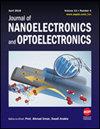A Comparative Study on the Degradation of Methylene Blue and Methyl Orange Dyes Under the Irradiation of Visible Light Using GO–CdO Nanocomposites
IF 0.6
4区 工程技术
Q4 ENGINEERING, ELECTRICAL & ELECTRONIC
引用次数: 0
Abstract
Cadmium oxide nanoparticles synthesized from alcoholic method using cadmium chloride monohydride and the composites with GO by simple dispersion method. Two nanocomposites with 5 Wt% and 10 Wt% loading of CdO over GO were prepared and named as GC1 and GC2 respectively. From XRD the CdO nanoparticles were of crystalline nature and were indexed to JCPDS card no: 05-0640 corresponding to Cubic lattice system. The particle like morphology of the CdO was confirmed by SEM and TEM. The decoration of monolayer GO sheets by CdO nanoparticles was unveiled through these studies. The Raman analysis reveals the presence of D and G peaks in the composites with an increased ID/IG ratio. UV-Vis study displays the absorption edge of CdO and a redshift is observed for GC2. From PL study, emission peak occurs at 358 nm for composites along with a quenching of intensity for GC2. The TG-DT analysis reveals the thermal stability of pristine and nanocomposites. Photocatalytic degradation of the as synthesized samples was studied for Methylene orange and Methylene blue dye using a Xenon lamp with 500 W. The degradation of the GC2 happens in 90 minutes with degradation efficiency 73% of was achieved for Methyl Orange dye. For Methylene blue the GC2 sample degrades only in 30 minutes with an efficiency of 94% was achieved.使用 GO-CdO 纳米复合材料在可见光辐照下降解亚甲基蓝和甲基橙染料的比较研究
利用一水氯化镉通过酒精法合成氧化镉纳米粒子,并通过简单的分散法与 GO 复合。制备出两种纳米复合材料,在 GO 上分别添加 5 Wt% 和 10 Wt% 的氧化镉,并分别命名为 GC1 和 GC2。从 XRD 可以看出,CdO 纳米粒子呈结晶状,并被归入 JCPDS 编号:05-0640 的立方晶格体系。二氧化镉的颗粒形态由扫描电镜和电子显微镜证实。这些研究揭示了氧化镉纳米粒子对单层 GO 薄膜的装饰作用。拉曼分析表明,随着 ID/IG 比率的增加,复合材料中出现了 D 峰和 G 峰。紫外可见光研究显示了 CdO 的吸收边缘,并观察到 GC2 的红移。聚光研究显示,复合材料在 358 纳米波长处出现发射峰,GC2 的发射强度骤减。TG-DT 分析表明了原始和纳米复合材料的热稳定性。使用 500 W 的氙灯研究了合成样品对亚甲基橙和亚甲基蓝染料的光催化降解。对于亚甲蓝染料,GC2 样品仅在 30 分钟内降解,降解效率为 94%。
本文章由计算机程序翻译,如有差异,请以英文原文为准。
求助全文
约1分钟内获得全文
求助全文
来源期刊

Journal of Nanoelectronics and Optoelectronics
工程技术-工程:电子与电气
自引率
16.70%
发文量
48
审稿时长
12.5 months
 求助内容:
求助内容: 应助结果提醒方式:
应助结果提醒方式:


